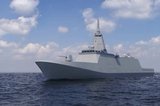Royal Navy’s Type 31 frigate to use half the crew of the Type 23 and embrace automation
The Type 31 frigate has been built with the human factor in mind. (Image: Royal Navy/Crown copyright)
Navies the world over are facing a trinity of issues: recruiting suitably qualified sailors; equipping larger, more effective ships with smaller crews; and, following the experiences of Covid-19, creating warships suitable for potential long-term living.
At last month’s Surface Warships conference in London, one expert speaker explained how the Royal Navy (RN) was tackling those challenges with radical, novel design and build features in its Inspiration-class Type 31 frigate.
The five-vessel Type 31 class was envisaged as a general purpose vessel to balance the RN’s frigate fleet, including the ageing Duke-class Type 23 and the significantly more high-end anti-submarine war machines
Already have an account? Log in
Want to keep reading this article?
More from Naval Warfare
-
![Thales’ new Sonar 76Nano could equip UK Royal Navy on anti-submarine warfare missions]()
Thales’ new Sonar 76Nano could equip UK Royal Navy on anti-submarine warfare missions
The new sonar is designed to equip uncrewed underwater vessels, with the potential to be used by the Royal Navy for its Atlantic Bastion and Atlantic Net missions.
-
![Hanwha wins Australian government approval to increase its stake in Austal]()
Hanwha wins Australian government approval to increase its stake in Austal
The contract would mean the two shipbuilders can collaborate strategically and enhance shipbuilding capabilities in Western Australia.
-
![Royal Australian Navy sizes up modernisation plans for new and existing capabilities]()
Royal Australian Navy sizes up modernisation plans for new and existing capabilities
The Australian navy is pushing ahead with its efforts to modernise its workforce and capabilities while balancing risky submarine upgrades, ageing Collins-class boats and a shrinking minehunter fleet. Head of navy capability RAdm Stephen Hughes updated Shephard on the force’s progress.





















